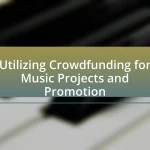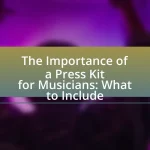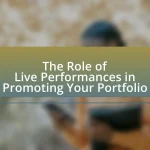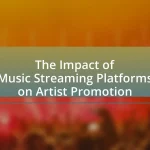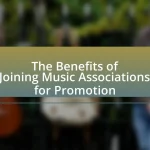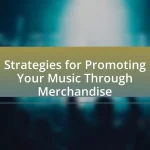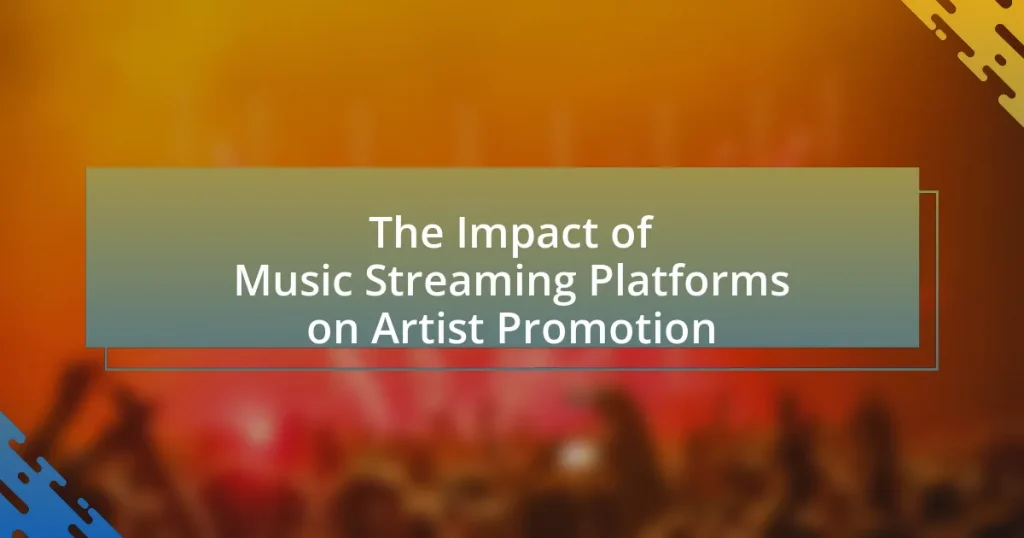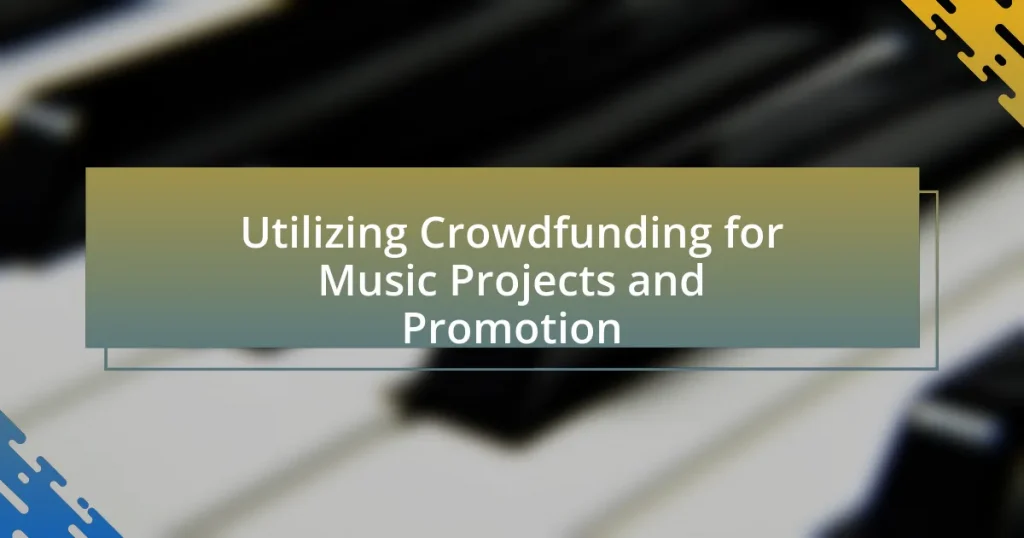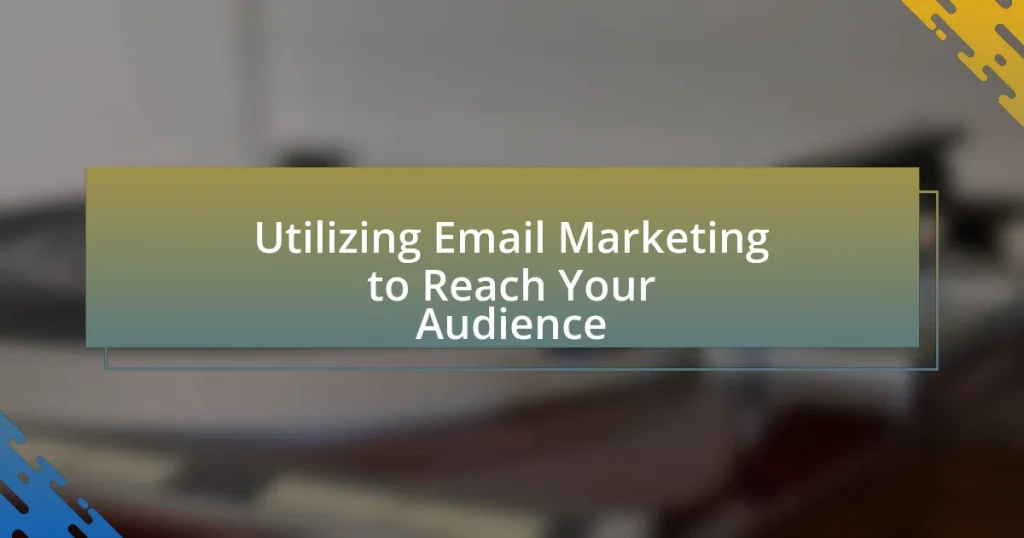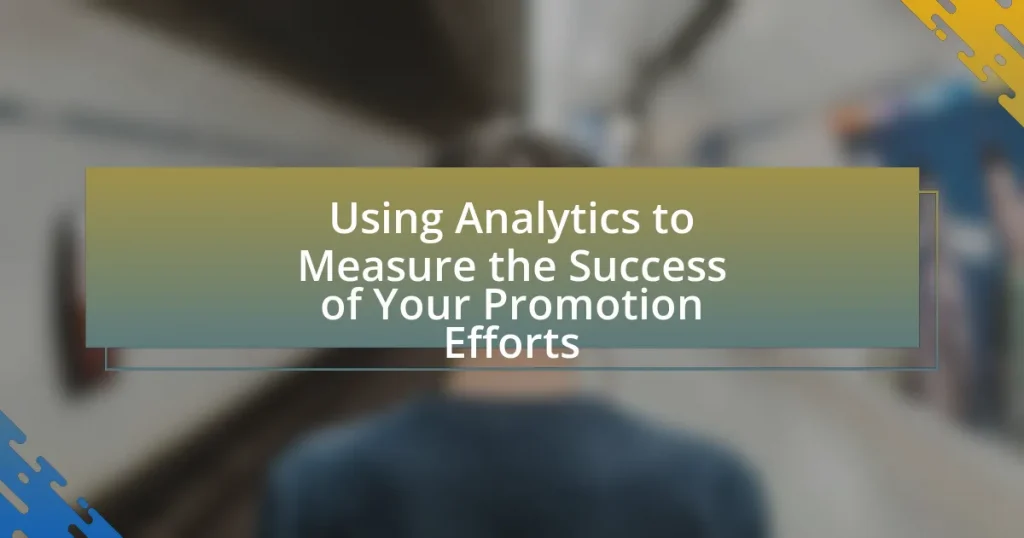The article examines the impact of music streaming platforms on artist promotion, highlighting how services like Spotify and Apple Music enhance accessibility and exposure for artists. It discusses the role of algorithms, curated playlists, and data analytics in promoting emerging talent and increasing visibility. Additionally, the article addresses the challenges artists face, including revenue distribution and competition, while outlining effective strategies for maximizing promotion on these platforms. Key trends and the influence of emerging technologies on future promotional strategies are also explored, emphasizing the evolving landscape of music distribution and marketing.
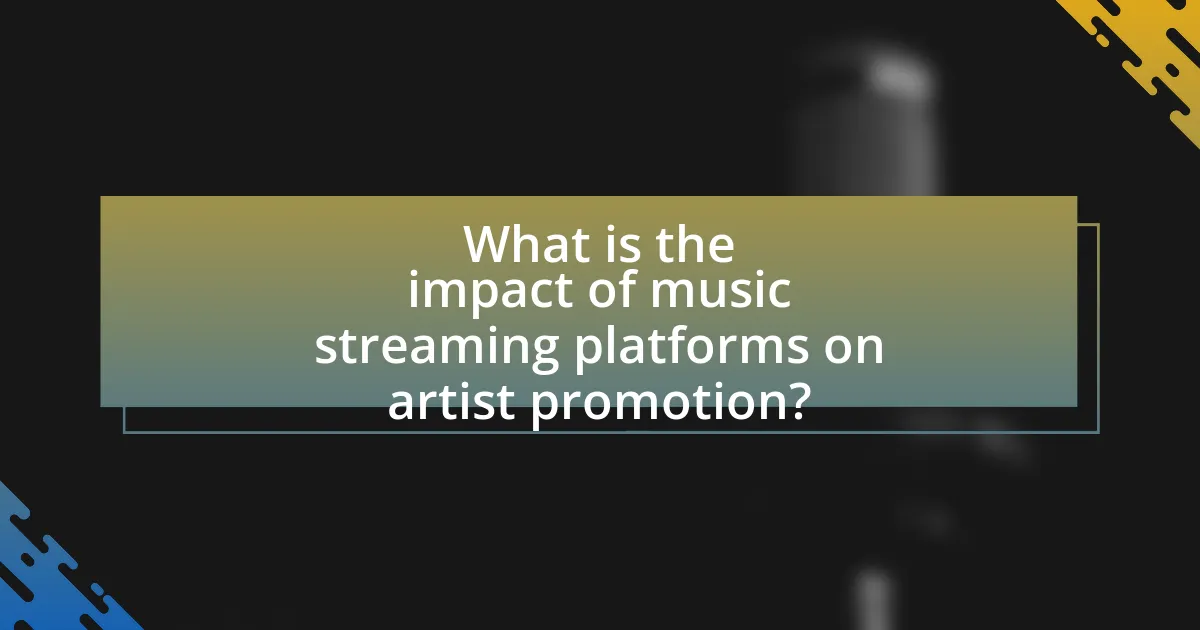
What is the impact of music streaming platforms on artist promotion?
Music streaming platforms significantly enhance artist promotion by providing widespread accessibility and exposure to a global audience. These platforms, such as Spotify and Apple Music, allow artists to reach millions of listeners without the traditional barriers of entry associated with physical distribution and radio play. For instance, Spotify reported that over 60,000 new tracks are uploaded daily, showcasing the platform’s role in democratizing music access and enabling independent artists to gain visibility. Additionally, algorithms and curated playlists on these platforms help promote emerging artists, increasing their chances of being discovered by new fans. This shift has led to a more diverse music landscape, where artists can build their fanbase through data-driven insights and targeted marketing strategies.
How do music streaming platforms function in promoting artists?
Music streaming platforms promote artists by providing them with a global audience and data-driven tools for visibility. These platforms utilize algorithms to recommend music to users based on listening habits, which increases the likelihood of new listeners discovering emerging artists. For instance, Spotify’s “Discover Weekly” and “Release Radar” playlists curate personalized music selections, often featuring lesser-known artists alongside popular tracks, thereby enhancing their exposure. Additionally, platforms like Apple Music and Tidal offer editorial playlists that highlight new releases, further supporting artist promotion. According to a report by the International Federation of the Phonographic Industry (IFPI), 70% of users discover new music through streaming services, underscoring their role in artist visibility and promotion.
What features of streaming platforms enhance artist visibility?
Streaming platforms enhance artist visibility through features such as curated playlists, algorithm-driven recommendations, and social sharing capabilities. Curated playlists, often created by platform editors or influencers, can significantly boost an artist’s exposure by placing their music alongside popular tracks, leading to increased streams and followers. Algorithm-driven recommendations analyze user listening habits to suggest new music, allowing lesser-known artists to reach potential fans who may enjoy their style. Additionally, social sharing features enable users to share songs or playlists on social media, further amplifying an artist’s reach and engagement. These features collectively contribute to a more dynamic and accessible environment for artists to gain visibility in a competitive market.
How do algorithms influence artist promotion on these platforms?
Algorithms significantly influence artist promotion on music streaming platforms by determining which songs and artists are recommended to users. These algorithms analyze user behavior, such as listening history and engagement metrics, to curate personalized playlists and suggestions. For instance, Spotify’s algorithm uses data from over 345 million users to create tailored experiences, which can lead to increased visibility for emerging artists. This data-driven approach not only enhances user experience but also directly impacts an artist’s reach and potential for discovery, as tracks that align with user preferences are more likely to be promoted.
What are the advantages of using music streaming platforms for artist promotion?
Music streaming platforms provide significant advantages for artist promotion by offering broad reach, data analytics, and cost-effectiveness. These platforms, such as Spotify and Apple Music, allow artists to distribute their music globally, reaching millions of listeners without the need for traditional distribution channels. Additionally, they provide valuable data analytics that help artists understand their audience demographics, listening habits, and geographic locations, enabling targeted marketing strategies. Furthermore, the low cost of entry for artists to upload their music makes it financially accessible, allowing emerging artists to promote their work without substantial investment. According to a report by the International Federation of the Phonographic Industry (IFPI), streaming accounted for 62.1% of global recorded music revenue in 2020, highlighting its importance in the music industry and its effectiveness in promoting artists.
How do streaming platforms provide access to a global audience?
Streaming platforms provide access to a global audience by utilizing the internet to distribute content, allowing users from various geographical locations to access music anytime and anywhere. These platforms, such as Spotify and Apple Music, employ algorithms and data analytics to recommend music based on user preferences, which enhances discoverability across diverse markets. For instance, Spotify reported that it has over 456 million monthly active users in more than 180 countries, demonstrating its extensive reach. Additionally, streaming services often offer localized content and playlists tailored to specific regions, further broadening their appeal and accessibility to a global audience.
What role do playlists play in promoting artists on streaming services?
Playlists play a crucial role in promoting artists on streaming services by increasing their visibility and reach to a broader audience. When an artist’s song is included in popular playlists, it can significantly boost streaming numbers, leading to higher chart placements and greater recognition. For instance, Spotify’s editorial playlists have been shown to increase an artist’s monthly listeners by an average of 30% after being featured. This exposure not only helps established artists maintain their popularity but also allows emerging artists to gain traction in a competitive market.
What challenges do artists face with music streaming platforms?
Artists face significant challenges with music streaming platforms, primarily related to revenue distribution and visibility. The revenue model of streaming services often results in artists receiving a fraction of a cent per stream, which can lead to financial instability, especially for independent musicians. For instance, a report by the Digital Media Association indicates that in 2020, the average payout per stream was approximately $0.003 to $0.005, making it difficult for artists to earn a sustainable income solely from streaming.
Additionally, the algorithms used by these platforms can limit exposure for emerging artists, as they often prioritize established acts or trending songs, making it challenging for new talent to gain traction. According to a study by the University of Southern California, over 90% of streams are concentrated among the top 1% of artists, highlighting the disparity in visibility and access to audiences. These factors collectively hinder artists’ ability to promote their work effectively and achieve financial success in the streaming landscape.
How does revenue distribution affect artist promotion?
Revenue distribution significantly impacts artist promotion by determining the financial resources available for marketing efforts. When streaming platforms allocate a larger share of revenue to artists, they enable those artists to invest in promotional activities such as advertising, music videos, and social media campaigns. For instance, according to a 2021 report by the International Federation of the Phonographic Industry, artists who receive higher payouts from streaming services are more likely to engage in extensive promotional strategies, leading to increased visibility and audience reach. Conversely, if revenue distribution is skewed in favor of the platforms, artists may struggle to fund their promotional initiatives, limiting their ability to connect with fans and grow their careers.
What are the implications of competition among artists on streaming platforms?
Competition among artists on streaming platforms leads to increased visibility and innovation in music production. As artists strive to stand out, they often enhance their marketing strategies, resulting in more engaging content and diverse musical offerings. For instance, platforms like Spotify and Apple Music utilize algorithms that favor popular tracks, pushing artists to create music that resonates with listeners, thereby driving higher engagement rates. This competitive environment can also lead to a saturation of the market, making it challenging for new artists to gain traction. According to a report by MIDiA Research, over 40% of music listeners discover new artists through playlists, highlighting the importance of competition in shaping listener preferences and promoting emerging talent.
How do music streaming platforms compare to traditional promotion methods?
Music streaming platforms offer a more direct and data-driven approach to artist promotion compared to traditional methods. Unlike traditional promotion, which often relies on radio play, physical sales, and print media, streaming platforms provide real-time analytics and targeted marketing opportunities. For instance, Spotify’s algorithm can curate personalized playlists for users, increasing exposure for artists based on listener preferences, which is a significant advantage over traditional radio that has limited reach and audience targeting. Additionally, a report by the International Federation of the Phonographic Industry (IFPI) in 2021 indicated that 70% of music consumers use streaming services, highlighting their dominance in music consumption and promotion. This shift allows artists to engage with their audience more effectively and measure the impact of their promotional efforts through metrics like streams, saves, and shares.
What are the key differences in reach and engagement?
Reach refers to the total number of unique users who are exposed to a piece of content, while engagement measures the interactions that users have with that content, such as likes, shares, comments, and plays. For instance, a song may reach a million listeners on a streaming platform, but if only a fraction of those listeners actively engage by adding the song to their playlists or sharing it, the engagement rate would be significantly lower. This distinction is crucial for artists and marketers, as high reach with low engagement may indicate that the content is not resonating with the audience, whereas high engagement suggests a strong connection with listeners.
How do costs of promotion differ between streaming platforms and traditional methods?
Costs of promotion on streaming platforms are generally lower than those associated with traditional methods. Streaming platforms often utilize targeted advertising and algorithm-driven recommendations, which can significantly reduce the cost per reach compared to traditional media like radio or television, where costs can be exorbitant due to airtime fees and production expenses. For instance, a Spotify ad campaign can start as low as $250, while a single 30-second TV spot during prime time can cost upwards of $100,000. This cost efficiency allows artists to allocate more resources towards creative content and engagement strategies, enhancing their promotional efforts in a more budget-friendly manner.
What strategies can artists employ to maximize their promotion on streaming platforms?
Artists can maximize their promotion on streaming platforms by utilizing targeted marketing strategies, engaging with their audience, and leveraging playlist placements. Targeted marketing strategies, such as social media advertising and email campaigns, allow artists to reach specific demographics, increasing their visibility. Engaging with their audience through live streams, Q&A sessions, and social media interactions fosters a loyal fan base, which can lead to increased streams and shares. Additionally, securing placements on popular playlists significantly boosts an artist’s exposure; for instance, songs featured on Spotify’s “Today’s Top Hits” playlist can experience a surge in streams, often leading to higher chart positions. These strategies collectively enhance an artist’s presence and success on streaming platforms.
How can artists effectively use social media to enhance their streaming presence?
Artists can effectively use social media to enhance their streaming presence by actively engaging with their audience and promoting their music through targeted content. By sharing behind-the-scenes footage, live performances, and personal stories, artists can create a deeper connection with fans, which can lead to increased streaming numbers. For instance, a study by the International Federation of the Phonographic Industry (IFPI) found that 70% of music listeners discover new music through social media platforms. Additionally, utilizing features like Instagram Stories, TikTok challenges, and Facebook Live can help artists reach wider audiences and drive traffic to their streaming profiles. Engaging with followers through comments and direct messages also fosters community, encouraging fans to share the artist’s music, further amplifying their streaming presence.
What best practices should artists follow for playlist submissions?
Artists should follow several best practices for playlist submissions to maximize their chances of being featured. First, they should research and target playlists that align with their genre and style, ensuring that their music fits the curator’s theme. Additionally, artists should personalize their submission messages, addressing the curator by name and explaining why their track is a good fit for the playlist.
Moreover, maintaining a professional online presence, including updated social media profiles and a well-crafted artist bio, can enhance credibility. Artists should also provide high-quality audio files and relevant metadata, such as song credits and release dates, to facilitate the curator’s review process.
Finally, following up respectfully after a submission can demonstrate professionalism and persistence, but artists should avoid being overly pushy. These practices are supported by industry insights, which indicate that personalized and targeted submissions significantly increase the likelihood of playlist placements.
What future trends can we expect in music streaming and artist promotion?
Future trends in music streaming and artist promotion include the rise of personalized algorithms, increased use of social media integration, and the growth of direct-to-fan platforms. Personalized algorithms will enhance user experience by curating music recommendations based on individual listening habits, as evidenced by Spotify’s success with its Discover Weekly feature, which has significantly increased user engagement. Social media integration will allow artists to promote their music more effectively through platforms like TikTok, where viral trends can lead to substantial increases in streams, demonstrated by the success of songs like “Old Town Road.” Additionally, direct-to-fan platforms such as Bandcamp are gaining traction, enabling artists to sell music and merchandise directly to their audience, thereby increasing revenue and fostering closer artist-fan relationships. These trends indicate a shift towards more interactive and personalized music consumption experiences.
How might emerging technologies influence artist promotion on streaming platforms?
Emerging technologies significantly influence artist promotion on streaming platforms by enhancing data analytics and personalized marketing strategies. These technologies enable platforms to analyze user behavior and preferences, allowing for targeted recommendations that increase an artist’s visibility. For instance, algorithms can identify potential listeners based on listening habits, leading to tailored playlists that feature specific artists, thereby boosting their reach. Additionally, advancements in artificial intelligence facilitate the creation of engaging content, such as interactive music videos or virtual concerts, which can attract more fans. According to a report by MIDiA Research, personalized playlists account for over 30% of total streams on platforms like Spotify, demonstrating the effectiveness of these technologies in promoting artists.
What role will data analytics play in shaping future promotional strategies?
Data analytics will play a crucial role in shaping future promotional strategies by enabling targeted marketing and personalized content delivery. By analyzing user behavior, preferences, and engagement metrics on music streaming platforms, artists and promoters can tailor their promotional efforts to specific audience segments. For instance, data from platforms like Spotify and Apple Music reveals listening habits, allowing artists to identify their most engaged listeners and optimize their marketing campaigns accordingly. This targeted approach has been shown to increase conversion rates, as evidenced by a study from the International Journal of Information Management, which found that personalized marketing can lead to a 20% increase in customer engagement. Thus, leveraging data analytics will enhance the effectiveness of promotional strategies in the music industry.
What practical tips can artists implement for effective promotion on streaming platforms?
Artists can implement several practical tips for effective promotion on streaming platforms, including optimizing their profiles, engaging with fans, and leveraging playlists. Optimizing profiles involves using high-quality images, writing compelling bios, and ensuring links to social media are active, which enhances discoverability. Engaging with fans through social media and live streams fosters a loyal community, increasing listener retention. Additionally, submitting tracks to curated playlists can significantly boost visibility; according to a study by Spotify, tracks featured on playlists can see an increase in streams by up to 300%. These strategies collectively enhance an artist’s presence and reach on streaming platforms.
